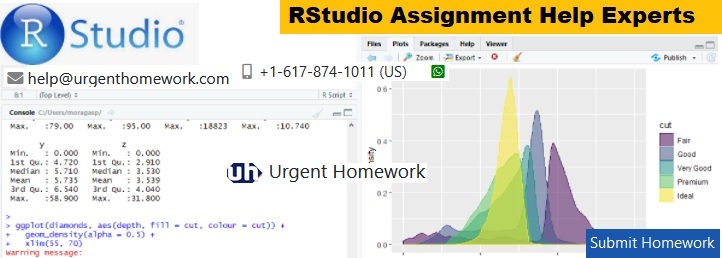RStudio Assignment Help

Hire Top Rated R Studio Assignment Help Experts To All of your R Scripts Assignments
R studio is taught as part of academic courses at several universities to teach students the fundamental functions and operations of the software. R Studio assignments are often provided to students as part of their course. Since R Studio is difficult to grasp, many students fail to complete R studio assignments correctly. This is why they seek R Studio assignment assistance from an academic service aimed at assisting them in maintaining their grades. R Studio is used in a variety of topics, such as statistics, data processing, and marketing, among others. The R programming language is used to create various statistical software that aids students in completing their assignments. SPSS, MS Excel, STATISTICA, R-Studio, and others are examples of applications.
Score High Grades By R Studio Assignment Helpers From Urgent Homework Experts
The professors expect you to write your R Studio assignment in a particular format. After data manipulation and analysis, the tasks usually consist of theoretical and empirical work that must be reported with relevant reports. To get good grades in tests, the formatting, structure, and content are all equally critical. To write a high-quality task, follow these steps:
- Read the instructions in the assignment query and take note of the requirements: universities always have assignment instructions and specifications. It must be followed in the style of the task. Otherwise, it would result in a grade reduction.
- Recognize the question's requirements: The assignment's content should meet or satisfy the question's requirements. Start working after you understand it.
Sample RStudio Homework Help Solved by R Markdown Assignment Help Experts
{`
You have a choice of two datasets for the final project.
1. The first dataset is COVID related and the observations are the states (and DC). There are 45 variables (columns) that are
mostly related to the pandemic, including the number of cases, whether they have mandatory quarantine for travelers, etc,
but also include the prevalence of depression, the air quality index and others.
2. The second dataset is from the World Bank. The rows are countries, and for each country we have various data, some of
them straightforward (GDP) and others which are not so clear (number of endangered bird species). There are 37 variables.
You are not expected to use all the variables in your analysis. We have provided more variables than you will use and
you can pick the variables according to the story you want to investigate and analyze.
`}
PROJECT COMPONENTS USING R MARKDOWN ASSIGNMENT HELP:
Introduction: Background, and describe the questions that you are asking, with some background
Exploratory Data Analysis: Variable descriptions (categorical or quantitative, what the variable measures, etc.), visualization, summary graphics, and summary statistics. In this part, we expect each member of your group to contribute at least one graph (the caption should include the name of the
person who created the graph. Data Analysis and Inference: Any inference you perform - including regression, hypothesis tests, parameter estimation. Discussion of why you chose your methods and plots. We would like you to include at least one regression and one hypothesis test in your analysis. Conclusion: What story does your data tell you? Provide the results of your final analysis (not all of the intermediate steps). Support your analysis with plots and tables. Discuss limitations and draw conclusions from your analysis. Compare results to other published work (if desired; and please cite all work used). References, if you looked at any other sources. This is not mandatory but may help you think of questions to ask.
HOW TO WORK ON YOUR PROJECT USING RStudio Homework Help
Discuss which dataset you want to work with (if you disagree, you may want to switch groups).
Intro: Brainstorm as a group about what you are curious about in the dataset. Take notes, the intro can contain questions that you don’t end up focusing on. You’ll probably write a draft as you meet and edit more carefully when you’ve pretty much completed the project. It might be good to assign group members to look at the data with particular questions in mind.
EDA:As individuals, look at plots, summary stats, think about questions you brainstormed about in the intro but be open to new questions or comparisons.
Data Analysis: (Hopefully) after everyone has completed EDA, get together and discuss. For some questions that have produced promising EDA plots, consider a regression line, hypothesis testing, and confidence intervals as ways to use what you’ve learned. Every project should have at least one hypothesis test (whichever kind(s) are appropriate for your analysis) and linear regression, and this may mean more plots in this section. Between the EDA and more formal data analysis, everyone in the group should be responsible for at least one plot along with its explanation.
Conclusion: Together you should reflect on what you learned and think about a coherent story to be told throughout the steps of the project. This can include some dead ends that you thought would be interesting but turned out not to be.
References: Along the way you should poke around online and see what other people have done with data like this. Refer to anything that you thought was interesting and/or influenced what you did.

